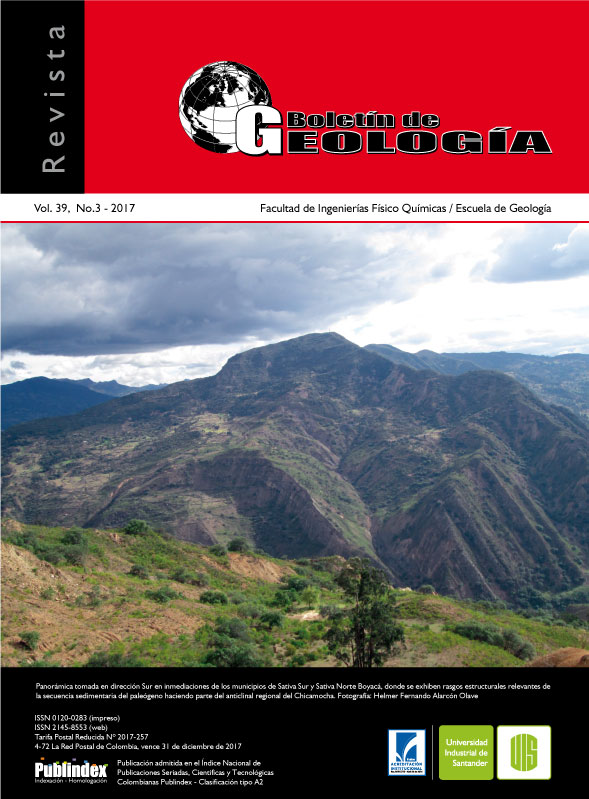Publicado 2017-10-06
Palabras clave
- tomografía computarizada de rocas,
- desplazamiento de dos fases,
- recobro mejorado,
- algoritmos numéricos
Cómo citar
Altmetrics
Resumen
La producción anual de crudo en Colombia ha aumentado año tras año, hasta alcanzar los 367 millones de barriles por año y una reserva probada de 2002 millones de barriles, en el 2016. Esto se debe a la intensificación de actividades de explotación de yacimientos maduros y de crudo pesado, y el uso de Técnicas de Recobro Mejorado (EOR). Estas buscan reducir la saturación de crudo en un yacimiento mediante la inyección de fluidos como solventes, polímeros, vapor y aire, principalmente. El porcentaje de recuperación en Colombia alcanzado con técnicas EOR es cercano al 21%. No obstante, su efectividad depende de: las características del crudo presente en el yacimiento, el mecanismo de empuje predominante en este, presión y temperatura, además de las propiedades petrofísicas de la roca que forma el yacimiento. Este trabajo aborda la estimación de las propiedades petrofísicas dinámicas de muestras de roca del horizonte productor mediante el uso de Tomografía Computarizada (acorde a sus siglas en inglés CT). Para esto se propone un conjunto de cinco algoritmos numéricos para la estimación de la porosidad efectiva, saturación, frente de avance, volumen atrapado y factor de recobro durante el desplazamiento de dos líquidos, crudo y agua, en el interior del medio poroso. El objetivo de la caracterización dinámica, mediante CT, es comprender y analizar los parámetros que influyen en el éxito de un desplazamiento de crudo en un medio poroso como parte de un esquema de producción mejorado en yacimientos maduros y de crudo pesado.
Descargas
Referencias
API RP-40. Recommended Practices for Core Analysis. Section 1- Planning a Coring Program. American Petroleum Institute. 1998.
Bansal, A., and Islam, M.R. 1991. State-of-the-art review of nondestructive testing with computer-assisted tomography. International Arctic Technology Conference. Society of Petroleum Engineers. Anchorage, Estados Unidos, pp. 523-534.
Blau, S., Robertson, S., and Johnstone, M. 2008. Disaster victim identification: new applications for postmortem computed tomography. Journal of Forensic Sciences, 53(4): 956-961.
Borkan, G.A., Hults, D.E., Gerzof, S.G., Robbins, A.H., and Silbert, C.K. 1983. Age changes in body composition revealed by computed tomography. Journal of Gerontology, 38(6): 673-677.
Buzug, T.M. 2008. Computed Tomography: From photon statistics to modern cone-beam CT. Springer. Leipzig, 522p.
Castro, R., Maya, G., Mercado, D., Trujillo, M., Soto, C., Pérez, H., Lobo, A., Ordóñez, A., and Sandoval, J.E. 2010. Enhanced Oil Recovery (EOR) Status - Colombia. SPE Latin American and Caribbean Petroleum Engineering Conference, Lima, Peru. SPE-139199-MS.
Cozzini, C., Olesinski, S., and Harding, G. 2012. Modeling scattering for security applications: A multiple beam X-Ray Diffraction Imaging system. IEEE Nuclear Science Symposium and Medical Imaging Conference, Anaheim, Estados Unidos, pp. 74-77.
Fajardo, R.J., and Müller, R. 2001. Three‐dimensional analysis of nonhuman primate trabecular architecture using micro‐computed tomography. American Journal of Physical Anthropology, 115(4): 327-336.
Hackley, P.C., Urbani, F., Karlsen, A.W., and Garrity, C.P. 2006. Mapa geológico de Venezuela a Escala 1:750.000. USGS.
Hunt, P., Engler, P., and Bajsarowicz, C. 1988. Computed tomography as a core analysis tool: Applications, instrument evaluation, and image improvement techniques. Journal of Petroleum Technology, 40(9): 1203-1210.
Kantzas, A. 1990. Investigation of physical properties of porous rocks and fluid flow phenomena in porous media using computer assisted tomography. In Situ, 14(1): 77-132.
Kellinghaus, M., Schulz, R., Vieth, V., Schmidt, S., Pfeiffer, H., and Schmeling, A. 2010. Enhanced possibilities to make statements on the ossification status of the medial clavicular epiphysis using an amplified staging scheme in evaluating thin-slice CT scans. International Journal of Legal Medicine, 124(4): 321-325.
Meyer, R.F., Attanasi, E.D., and Freeman, P.A., 2007. Heavy oil and natural bitumen resources in geological basins of the world: U.S. Geological Survey Open-File Report 2007-1084.
OPEC. 2016. OPEC - Oil data: upstream. Consultado el 1 de diciembre de 2016. http://asb.opec.org/index.php/interactive-charts/oil-data-upstream
Owen, N., Inderwildi, O., and King, D. 2010. The status of conventional world oil reserves-Hype or cause for concern?. Energy Policy, 38(8): 4743-4749.
Pani, S., Cook, E., Horrocks, J., George, L., Hardwick, S., and Speller, R. 2009. Modeling an energy-dispersive X-ray diffraction system for drug detection. IEEE Transactions on Nuclear Science, 56(3): 1238-1241.
SGC. 2015. Mapa Geológico de Colombia. Servicio Geológico Colombiano. Consultado el 01 de diciembre de 2016. http://geoportal.sgc.gov.co/geoportalsgc/catalog/main/home.page
Shameem, S., and Khamees, A. 2004. Dual-Energy CT-Scanning Applications in Rock Characterization. SPE Annual Technical Conference and Exhibition. Houston, Estados Unidos, pp. 26-29.
Shannon, C. E. 1949. Communication in the presence of noise. Proceedings of the IRE, 37(1): 10-21.
Smith, F. 1999. Industrial Applications of X-Ray Diffraction. CRC Press. Nueva York, 1006p.
Speight, J.G. 1997. Petroleum chemistry and refining. CRC Press. Nueva York, 350p.
Strecker, H. 1998. Automatic detection of explosives in airline baggage using elastic X-ray scatter. MedicaMundi, 42(2): 30-33.
Tafforeau, P., Boistel, R., Boller, E., Bravin, A., Brunet, M., Chaimanee, Y., and Kay, R.F. 2006. Applications of X-ray synchrotron microtomography for non-destructive 3D studies of paleontological specimens. Applied Physics A, 83(2): 195-202.
Thali, M.J., Taubenreuther, U., Karolczak, M., Braun, M., Brueschweiler, W., Kalender, W., and Dirnhofer, R. 2003a. Forensic microradiology: Micro-Computed Tomography (Micro-CT) and analysis of patterned injuries inside of bone. Journal of Forensic Sciences, 48(6): 1336-1342.
Thali, M. J., Yen, K., Schweitzer, W., Vock, P., Ozdoba, C., and Dirnhofer, R. 2003b. Into the decomposed body-forensic digital autopsy using Multislice-Computed Tomography. Forensic Science International, 134(2): 109-114.
Uda, M., Demortier, G., and Nakai, I. 2005. X-rays for Archaeology. Amsterdam, Dordrecht, The Netherlands. Springer, 301p.
Wellington, S.L., and Vinegar, H.J. 1987. X-ray computerized tomography. Society of Petroleum Engineers, 39(8): 885-898.
Wheeler, J.O., Hoffman, P.F., Card, K.D., Davidson, A., Sanford, B.V., Okulitch, A.V., and Roest, W.R. 1996. Geological Map of Canada, Map D1860A, Geological Survey of Cannada, Ottawa, Ontario.
Withjack, E.M. 1988. Computed tomography for rock-property determination and fluid-flow visualization. SPE Formation Evaluation, 3(4): 696-704.
